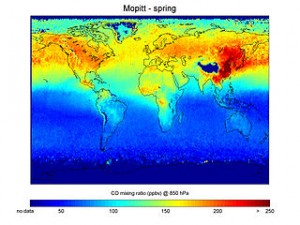In part 1, the search for cleaner San Joaquin Valley, California air is on. In comparing years 2010 and 2012, looked at will be total organic gases (TOG), reactive organic gases (ROG), carbon monoxide (CO), nitrogen oxides (NOx), sulfur oxides (SOx), particulate matter (PM), coarse particulates (PM 10) and fine particulates (PM 2.5) coming from the following three sources: Stationary, Areawide and Mobile. Question is: Is Valley air showing signs of improvement and, if so, in what categories? Same exact questions for the state’s South Coast region which is what will be explored in Part 2.
2010 vs. 2012: An air quality comparison

I would like nothing more than not having to think about the pollution that’s in the air. One thing about dirty air is that it never escapes visual detection. Sometimes it stinks, though not always, that is, in the sense that there is not an odor attached to it at all times. It’s one thing to see or smell said pollution. It’s another to know where it’s coming from and still another to know what it’s composed of. Furthermore, it is important to understand what pollution’s effect on cardiovascular and respiratory health is and what kinds of treatment regimens are being administered. As to the last item, it is helpful to know conducted research in this regard is ongoing. Gaining and having a far better understanding of any and all of the above is what this is about.
So where is air pollution coming from and what pollutants are we talking about?
As far as air pollution sources go, here is the breakdown lowdown. The California Environmental Protection Agency Air Resources Board (ARB) categorizes the sources (stationary, areawide, mobile) by sector. These are:
Stationary
- Fuel combustion
- Waste disposal
- Cleaning and surface coatings
- Petroleum production and marketing
- Industrial processes
Areawide
- Solvent evaporation
- Miscellaneous processes
Mobile
- On-road motor vehicles
- Other mobile sources
(Source: “Almanac Emission Projection Data (Published in 2013), 2012 Estimated Annual Average Emissions, San Joaquin Valley Air Basin,” California Environmental Protection Agency Air Resources Board. See: http://www.arb.ca.gov/app/emsinv/2013/emseic1_query.php).
It is no surprise that the single largest contributor of the air emissions of carbon monoxide (CO) and nitrogen oxides (NOx) is the mobile-sources sector. Contributions in tons per day of each are as follows:
- CO – 690.1
- NOx – 275.5
Surprisingly, the largest contributor of air emissions of total organic gases (TOG), reactive organic gases (ROG), particulate matter (PM), coarse particulates (PM 10) and fine particulates (PM 2.5) is the Areawide-sources sector. Contributions in tons per day are:
- TOG – 1022.1
- ROG – 176.2
- PM – 488.4
- PM 10 – 250.2
- PM 2.5 – 54.0
Meanwhile, the Stationary-sources sector contributes the largest amount of sulfur oxides (SOx) of all three sectors. Stationary sources produce 7.9 tons per day of SOx.
In all, every day the San Joaquin Valley produces:
- TOG – 1764.1
- ROG – 357.9
- CO – 902.6
- NOx – 325.2
- SOx – 10.4
- PM – 528.5
- PM 10 – 281.6
- PM 2.5 – 75.6
Long-term, getting control of (meaning: “reducing” or “removing”) these pollutants in Valley air, goes without saying. Right now, the $64 million question is: How is the Valley faring in this regard compared to previous years?
Looking at the same numbers for 2010 reveals Valley air has gotten slightly cleaner. So, there has been some progress, that is, in regard to those identified pollutants.
In 2010, from the same sources in tons per day the Valley generated:
- TOG – 2077.1
- ROG – 408.5
- CO – 984.3
- NOx – 363.1
- SOx – 11.9
- PM – 532.5
- PM 10 – 284.0
- PM 2.5 – 76.9
(Source: “Almanac Emission Projection Data (Published in 2013), 2010 Estimated Annual Average Emissions, San Joaquin Valley Air Basin,” California Environmental Protection Agency Air Resources Board. See: http://www.arb.ca.gov/app/emsinv/2013/emseic1_query.php).
Was the improvement due to more favorable meteorological conditions 2012 versus 2010? Or, can this improvement be attributable to other factors?
Incidentally, I looked at the numbers for year 2005, and except for TOG, there has been continued improvement. TOG in 2005 was 2,039.7 tons per day, indicating that TOG had increased between 2005 and 2010.
Interesting to see is if there is like improvement in the South Coast region. That will be covered in Part 2.
Image above: NASA
– Alan Kandel